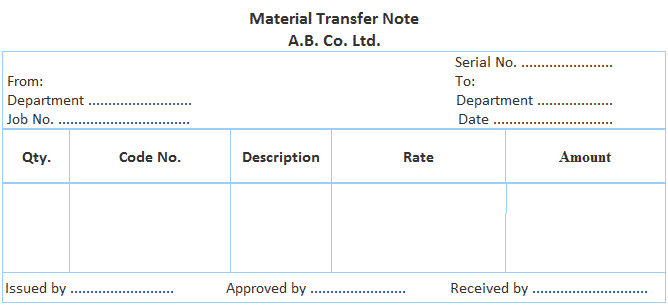Transfer of Materials: Definition
The direct transfer of surplus materials from one job or work order to another is, as a rule, undesirable. It should be discouraged as far as possible.
It is, however, justified when an urgent job must be completed. In these cases, it may be necessary to appropriate surplus materials to avoid the delays inherent in the normal routine of returning materials to stores and then re-issuing them.
Material Transfer Note: Explanation
All transfers of materials must be accompanied by a material transfer note.
This note is signed by the foremen of the sending and receiving departments and forwarded to the costing office, where the necessary adjustments are made in the respective job accounts.
Specimen/Format of Material Transfer Note
A specimen of a material transfer note is given below.

Transfer of Materials FAQs
A material transfer note can be used for transferring materials, equipment, stores or work in progress. However, it is advisable to have separate notes for different types of activities.
Discrepancies are common when transferring materials between different departments or locations. In most cases, the receiving department would have the final say on the quantity and quality of the transferred materials. The discrepancies should be resolved and appropriate adjustments made to the job accounts before the final Financial Statement is prepared.
If there is no material transfer note, the materials are assumed to be transferred on account of internal transfers.
If there is no receiving department's signature, the materials are assumed to have been issued by the sending department and not returned at all. If this is not possible due to some reason, the receiving department should sign the material transfer note with 'received in part' notation.
A material transfer note is a document used for recording the direct transfer of materials from one job or work order to another. It is signed by the foremen of the sending and receiving departments and forwarded to the costing office, where the necessary adjustments are made in the respective job accounts.
True Tamplin is a published author, public speaker, CEO of UpDigital, and founder of Finance Strategists.
True is a Certified Educator in Personal Finance (CEPF®), author of The Handy Financial Ratios Guide, a member of the Society for Advancing Business Editing and Writing, contributes to his financial education site, Finance Strategists, and has spoken to various financial communities such as the CFA Institute, as well as university students like his Alma mater, Biola University, where he received a bachelor of science in business and data analytics.
To learn more about True, visit his personal website or view his author profiles on Amazon, Nasdaq and Forbes.











